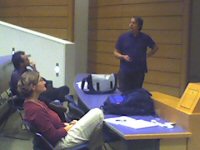Main Menu
Welcome
 In the last talk of the symposium, NYU's Claude Desplan talked about research on color vision in Drosophila his student Satoko Yamaguchi (supervised by genius Reinhard Wolf) is doing in my home town Würzburg in the lab of my thesis supervisor Martin Heisenberg. He described a new version of a "novelty-choice" paradigm originally developed by Marcus Dill. Here, the animals fly stationarily on a torque meter (similar to my flight simulator) with two screens in front of it (at an angle). If the flies see the same color for a certain period of time on both screens and then one of the screens shows a new color, the flies tend to turn towards the screen with the new color. Then you can use the genetic tools in Drosophila to dissect the fly visual system one neuron at a time. And this is what Claude's talk was all about.
In the last talk of the symposium, NYU's Claude Desplan talked about research on color vision in Drosophila his student Satoko Yamaguchi (supervised by genius Reinhard Wolf) is doing in my home town Würzburg in the lab of my thesis supervisor Martin Heisenberg. He described a new version of a "novelty-choice" paradigm originally developed by Marcus Dill. Here, the animals fly stationarily on a torque meter (similar to my flight simulator) with two screens in front of it (at an angle). If the flies see the same color for a certain period of time on both screens and then one of the screens shows a new color, the flies tend to turn towards the screen with the new color. Then you can use the genetic tools in Drosophila to dissect the fly visual system one neuron at a time. And this is what Claude's talk was all about.In flies, the photoreceptor cells R7 and R8 are responsible for color vision (R1-R6 are responsible for motion detection). The two color receptors project deeper into the brain than the R1-R6 receptors (into the Medulla compared to the Lamina for R1-R6). R7 and R8 each express two different opsins (rh4-rh7) in a mosaic pattern distributed over the fly eye. So you have two types of R7 and two types of R8 that mix randomly over the surface of the eye. Claude then went on to describe how R7 and R8 connect to about 15 types of downstream neurons in the Medulla. Not surprisingly, there are both local and projecting neurons in the Medulla making connections to R7 and R8. Apparently, he now wants to switch off all of these neuron types one by one and then test them behaviorally, but he didn't talk about that at all, so I guess this is ongoing work.

Posted on Wednesday 25 July 2007 - 21:18:29 comment: 0
{TAGS}
{TAGS}
Render time: 0.0579 sec, 0.0042 of that for queries.





